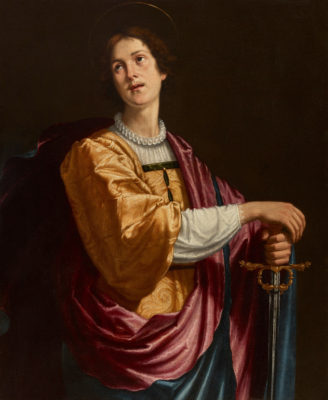Jacopo Chimenti, called Jacopo Da EMPOLI
(Florence, 1551-1640)
Saint Julian.
Circa 1610-1620.
Oil on canvas
110x92cm (43 5/16 x 36 1/4 in.).
This painting very likely represents the young nobleman Julian, who according to a celebrated ancient legend was destined to unwittingly murder his parents with a sword. Having become aware of the bloody prophecy, Julian fled far from home, settling in a castle with his wife. One day, two tired and hungry travellers sought hospitality from the young woman, and when she understood from their story that they were her parents-in-law, offered them her bed. Julian had been out, and upon returning he was convinced he had found his wife in bed with a lover, and killed the couple as they slept. He then went through an intense period of penitence, ultimately gaining his reward in Heaven.
For reasons of style, the canvas should be included in the mature oeuvre of Jacopo da Empoli, and can thus be dated to the 1610s, when the painter had moved away from the rigid training founded entirely on drawing from nature — based on the great masters of the sixteenth century such as Fra Bartolomeo, Andrea del Sarto and Santi di Tito — and adopted the softer handling of Cigoli and Matteo Rosselli, giving his figures greater sentiment and expression.
Characterized by clean, finely-drawn contours, typical of Empoli and noticeable above all in the folds of the collar, cuffs and highly finished sword hilt, the saint stands out against a dark background, thanks to the bright, contrasting colours of his clothing — a damasked yellow tunic and violet-red and blue cloak. Light softens the forms, lending aristocratic elegance to the figure’s solidly-modelled structure and dignified facial features. The clearly-defined physiognomy we see here would suggest that Empoli (as was his custom) used a young model, investing him with the devout, slightly languid looks appropriate to a holy person.
Jacopo da Empoli’s oeuvre contains numerous parallels supporting this attribution, as opposed to the implausible one to Jacopo Tarchiani, initially put forward by Giuseppe Cantelli, who now agrees on Empoli’s authorship (1). The same precisely-drawn collar recurs in the figure of Tobias in the Prayer of Sarah and Tobias sold at Sotheby’s in Florence in 1977 and now in a private collection. The hand holding the sword is almost identical to that of Saint John in the Preaching of the Baptist in San Niccolò Oltrarno (c. 1608), for which there exists a preparatory study, reversed, in the Musée du Louvre in Paris (inv. no. 1039, black chalk on grey-beige paper, 399 x 269 mm). The fine Florentine altarpiece is also helpful for a comparison between the dress of the turbaned woman seated with her back to us in the left foreground, with its alternating lozenge and arabesque patterns, and the clothing worn by the beautiful man in our canvas. Furthermore, the weighty fall of the saint’s cloak resembles that of the Virgin in the Virgin and Child with Angels and Saints Nicholas of Bari, Giuliana Falconieri, John the Baptist and Andrew in the Del Palagio chapel in Santissima Annunziata in Florence, completed in 1618.
As always, Jacopo da Empoli’s art comes across as elegant and devout, but here it also conveys a more intense level of expressive feeling, and stands at the very limits of psychological introspection, reflecting the poetics of affetti established in Florence by Cristofano Allori during the first decade of the 1600s.
Francesca Baldassari
1 G. Cantelli, Repertorio della Pittura Fiorentina del Seicento, Fiesole, 1983, p. 135, fig. 695 (as Jacopo Tarchiani, with subject identified as a saint with a sword); idem, entry in Pandolfini auction catalogue, 26 November 2014, lot 44, as Jacopo da Empoli, the subject given as Saint Crescentinus.
